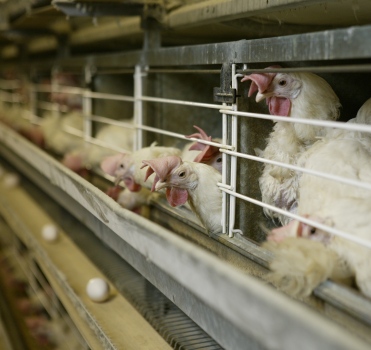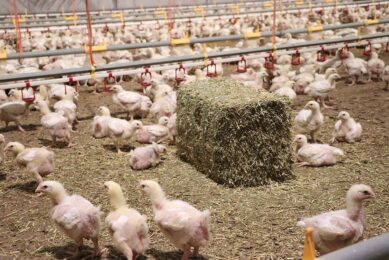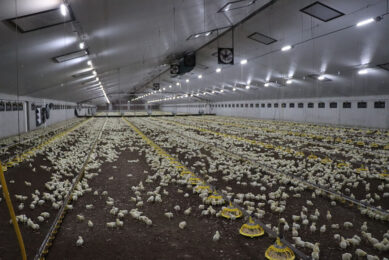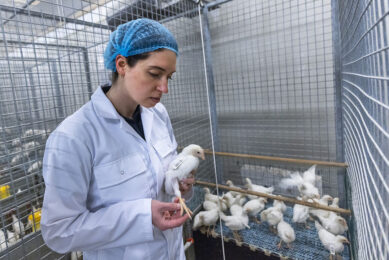Salmonella thrives in cage housing

The poultry industry is permanently fighting the battle against Salmonella. That is certainly not without reason, as Salmonella is an important cause of gastrointestinal disease in humans throughout the world. It is likely that the type of housing that layer hens are kept in influences the occurrence of infection. This appears to be in the advantage of flocks that are reared in alternative housing systems in comparison to cage systems.
By Prof. Dr. Jeroen Dewulf, Faculty of Veterinary Medicine, Ghent University, Merelbeke, Belgium
As of January 2012, housing of laying hens in battery cages will be forbidden in the EU and only alternative housing such as enriched cages and non-cage systems (barn, free-range and free-range organic) will be allowed. This ban on battery cages aims to improve the welfare of laying hens, yet it has also initiated the question whether there aren’t any adverse consequences of this decision on the spread and/or persistence of infectious (zoonotic) diseases in a poultry flock. This fear is based on the opinion that a big advantage of conventional battery cages is that, because hens are separated from their faeces, the risk of disease transmission through the faeces can be minimised. It was argued that the increased exposure of layers to environmental contaminations in non-cage systems can increase the risk of Salmonella infections.
Salmonella remains an important cause of gastrointestinal disease in humans worldwide. In Europe, S. Enteritidis (predominantly originating from poultry) and S. Typhimurium (predominantly originating from swine) are the most commonly isolated serotypes in human cases of salmonellosis. Contaminated eggs still remain the most important source of infection of S. Enteritidis for humans.
Effect of the housing system
A number of field studies, varying from small to very large, have evaluated the effect of the housing system on the occurrence of Salmonella. As often is the case, these studies have variable results going from a reduced risk of Salmonella contamination in cage systems, to no influence of the housing system, to an increased risk.
Two studies (one in laying hens and one in pullets) have found a lower level of Salmonella infection in laying hens housed in cage systems in comparison to deep litter systems. Meanwhile, four studies have found no significant effect of the housing system on the occurrence of Salmonella. However, six studies found an increases risk of Salmonella infection in laying hens housed in cage systems in comparison to the alternative housing systems.
Of course, it is difficult to summarise all these results into one single conclusion concerning the effect of the type of housing as a result of both the variable study design and the variable outcome. Nevertheless, the majority of the studies clearly indicate that a cage housing system has an increased risk of being Salmonella-positive in comparison to non-cage housing systems.
Although the majority of the studies indicate that cage systems have an increased risk of testing positive for Salmonella, this does not necessarily mean that there is a causal relationship between the housing type and infection. On the contrary, it is more likely that the effect attributed to the housing system is in reality influenced by several other production characteristics, such as magnitude of the flock or the herd, age of the building, probability of previous Salmonella infections on the farm, etc. The most important production characteristics that are most likely to be related to the housing system and the probability of a Salmonella infection are discussed below.
Herd and flock size
In general, cage flocks are larger than alternative flocks. They do not only have more birds per flock, but often also more flocks per herd. It has been shown in several studies that both the number of flocks, and thus the number of hens in a herd, as well as the number of hens in a flock are, independently from the production type, significant risk factors for Salmonella. The presence of multiple flocks in one herd may enhance the risk of cross-contamination of infection from one flock to another, especially since in multi-house systems there are often open pathways between houses to give way to conveyor belts, feed pipes, passageways, etc. This close association of houses makes it easy for infections to be transferred from one flock to the other, particularly by rodents. This risk is even further increased if the flocks present are in different stages of production.
Related to both production type and flock size is stocking density. For many infectious diseases in production animals it has been demonstrated that an increased stocking density also increases the prevalence of disease and the ease of spread.
Stress factors
Stressors such as re-housing, thermal extremes, transport, initiation of egg lay and molting have all been shown to exacerbate infection problems in poultry. Additionally, the housing conditions may influence the stress level in the animal and as a result influence Salmonella prevalence. In the effect of housing systems on the stress levels in animals, literature presents some conflicting results. Some suggest that birds have less stress in cage systems, whereas others found that hens housed in non-cage environments experience less stress. As a result it is difficult to conclude which of the systems induces the highest stress in the birds.
Age of the building
Salmonella is a micro-organism that can survive for a very long time (up to one year). As a result, after having experienced a Salmonella infection in a flock, it is not easy to fully get rid of this infection, even with cleaning and disinfection. This is why carry-over of infection from one production cycle to the next occurs very frequently. Therefore, the older a system is, the greater the chance that there is some historical infection that may be carried over.
In general, conventional battery cages are older than alternative production systems, such as floor raised or free-range systems. Older systems, independently of the type, may also be more difficult to thoroughly clean and disinfect.
Rats and mice
It has been suggested that cage houses present a more attractive environment to pests such as rats and mice compared to free-range systems since birds are restrained in cages and do not interfere with their movements. It has also been shown that these rodents are capable of spreading Salmonella.
Protective vaccination
The use of vaccination against Salmonella has a clear protective influence on the shedding of Salmonella. It is interesting to note that studies have reported the disappearance of Salmonella after vaccination in free-range flocks, but not in cage flocks. This may again be an indication of the lower challenge of birds in free-range conditions.
Exotic Salmonella species
Because S. Typhymurium is much more common in wildlife, pigs and cattle, it has been postulated that free-range laying flocks will be at greater risk of becoming infected with S. Typhimurium than other production types. It has also been suggested that production systems where hens have access to outdoor facilities are more likely to become infected with less frequently (other than S. Enteritidis and S. Typhimurium) encountered Salmonella serovars. Yet, this cannot be confirmed based on the studies currently available.
Conclusions
Based on epidemiological data provided above it can be stated that it is highly unlikely that a move from conventional battery cage systems to alternative cage systems and non-cage housing systems for laying hens will result in an increases in Salmonella infection and shedding. Rather, the opposite is expected. The true underlying mechanism that causes the prevalence of Salmonella to be generally lower in alternative housing systems in comparison to cage systems has not been identified as yet. It is likely to be a combination of factors influencing the infection pressure in the herd.
Join 31,000+ subscribers
Subscribe to our newsletter to stay updated about all the need-to-know content in the poultry sector, three times a week. Beheer
Beheer








 WP Admin
WP Admin  Bewerk bericht
Bewerk bericht